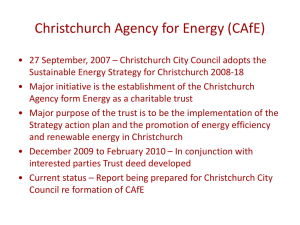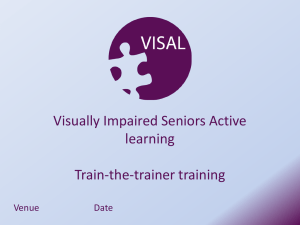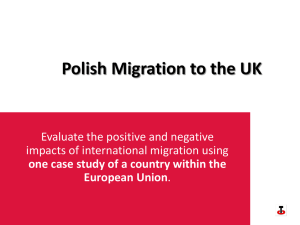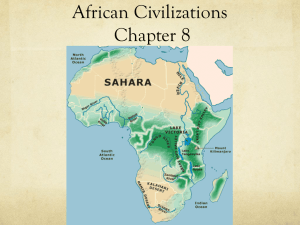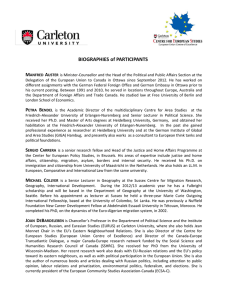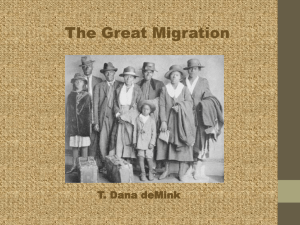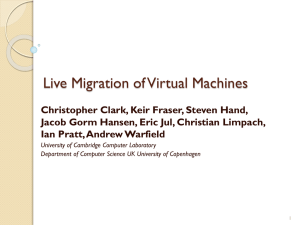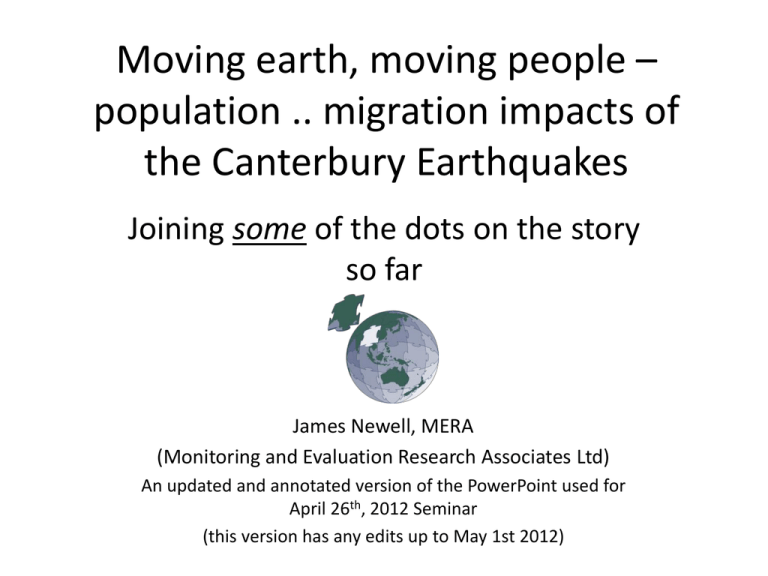
Moving earth, moving people –
population .. migration impacts of
the Canterbury Earthquakes
Joining some of the dots on the story
so far
James Newell, MERA
(Monitoring and Evaluation Research Associates Ltd)
An updated and annotated version of the PowerPoint used for
April 26th, 2012 Seminar
(this version has any edits up to May 1st 2012)
Picking up some of the threads from ..
• Three professional meets - November 2011
– Population and Employment Effects of the
Christchurch Earthquakes … workshop… Lincoln
University
– “Natural Disasters : Impact Assessment for
Sustainable Recovery” – NZ Association for Impact
Assessment 2011 Conference - Lincoln University
– 2011 Population Association of NZ Conference –
Auckland University
Picking up the threads from November
conferences ..
• NZAIA conference – local follow up called for – Dr Nick
Taylor leads this for NZAIA
• NZAIA with Canterbury Health organised this seminar
… asked me to present some of my work
– Present some results from population monitoring - as food
for discussion
– first in a seminar series?
– Sharing work / discussion of impacts and associated
management in the recovery process …
• NZAIA has set up a web forum and 2011 conference &
workshop archive –
– www.impactsforum.weebly.com
The work presented here …
• Picks up from the “Population.. Effects” workshop
• Clear that the workshop skimmed the surface and
understanding migration / population effects of the EQ a
work in progress – very live
• Inspiration / motivation
– Discussion with David Johnston (Centre for Disaster
Research / GNS Science) and Sarah Beaven (Social
Science liaison – Natural Hazards Platform)
– Needed at least to document, digest, disseminate
content of the November 2011 workshop
In writing up the workshop – clear that
• A lot of spade work needed to make sense of the
evidence, estimates and future expectations on
migration and population
• Incomplete and a lot of useful information not included
in November
• Much of the evidence not connected
• Not analysed except superficially
• Assumptions not stated – needed to be drawn out
• … much of the evidence only just coming available
Where I am coming from?
• More than 25 years hands on local “at the coal face”
experience with
• Population estimates and forecasting models
– Urban growth models for local government
• Special interest in understanding migration flows
– within and between regions
– international migration flows (university research projects,
science programmes, international studies and operational
models for central and local government
– Labour and educational capital flows – especially trans Tasman
• Labour market studies / employment patterns –
employment, occupational and industry trends
– demographic groups and communities
So …. over the last four to five
months…
• Collate / collect / analyse more carefully the
evidence
• Draw out the assumptions behind the estimates
and explore the ramifications of those estimates
• explore the future implications – integrate into
existing and updated future scenarios
• Document / write-up the results into an updated
and extended state of play…
• initial discussions on the draft results /
conclusions
.. In detail
• Raw data– the raw evidence base, metadata, statistics, LIS
layers ….
• Estimates – conversions and adjustments to raw statistics into
standardised measures and our best guesses on any derived
statistics and population parameters
• Systems – models for integrating the estimates to address end
uses including derived statistics
• Forecasting tools – local authority level cohort component
computer software programme that replicates SNZ tla
population projections and linked household formation and
labour force projection models
• Expectations - current and some partially updated future and
resulting future population scenarios
For this seminar
• At its base – very technical– masses of
statistics, models, estimates, many stories
• Far too much to fit into a 45 minute session
• At one level some very complex technical
work on statistics, estimates, models …
• Picking out a few key results around some key
questions
What we ..
know – the evidence base – recent past / now
… official and admin statistics (records)
best guesses - of the past / now …
… estimates
“predict” – future expectations
… projections (scenarios)
People moves - after the earth moved
..
What we know – the evidence base
… official and administrative statistics
What we think we know … our best guesses …
estimates and assumptions behind those
What we think is likely to happen in the future
projections / scenarios / predictions
Major part of this is the refinement of an existing
subnational population accounting model
Red components
are derived by
combining others
Blue components
are based on MERA
custom series
12
In practice – it combines..
• Top down
– Official and other summary statistics and surveys
– Vital statistics (births and deaths), external
migration movements, building consents,
population estimates …
• Bottom up
– Operational and administrative records
– School roll returns by school .. Ece …
– Property records and assessments..
Why is understanding population important?
• Large short term and medium term changes in
– population size, composition and distribution
• Major decisions in terms of reinvestment with long
term implications need to be made
– Schools, Roads and other infrastructure, business location
…
• Information important for public and private sector
interests
• An major urban centre is a cloth woven around
– its population
– its settlement pattern
– associated public and private land uses
People, homes, land, jobs …
People
Jobs
• Age-sex (Stage)
• Skills, Work,
Dependency,
Activity status
• Income
• Workplaces,
Industries
Families /
Dwellings
• Land
• Infrastructure
The focus here is “regional”
• Focussed mainly on the “strategic level”
• Is “Greater Christchurch”
– Christchurch City, Waimakariri Di, Selwyn Di)
• Includes some localised meshblock, area unit, ward
results to inform the “strategic picture”
• Understanding population and migration is “layered” at
different geographic levels
– Nation – region – local authority – neighbourhood /
suburb
– At very local neighbourhood level – have regional effects
and processes
– but also other processes not mirrored at a “regional” level
Questions : methods/tools/systems,
evidence/estimates/scenarios
• Migration and population effects so far?
– Need to see recent post 2006 and post EQ trends
in a historical context
• Who has/is moving and where?
– Need to use a formal population accounting
framework
• What does this suggest for the future growth
path?
– Projection scenarios old and new
What do we know about population
and migration change (since 2010)?
• We only have estimates
– Statistics NZ for June year population
• 5 years + since the last population census
• 2011 census a casualty of the February 2011
census
• Next census in 2013 – results in 2014?
• 2006 to 2012 – huge changes in jobs and
migration – where are we now?
Canterbury 2010/2011 EQ
Population migration effects in
context …
Some crude comparative statistics - Part 1
Adapted in part from : Beaven & Pearson 2011
Event
Short term
movements
Population effect
scale
Recovery
Canterbury
2010/2011
15-20% relocated
for some days ..
2.4% drop in year 1
(9,000)
Population recovery
starts in year 2?
Loma Prieta
Earthquake
.3% fall in San
Francisco County
1 year recovery
Northridge
Earthquake
1% fall in San
Fernando Valley
(~12,000)
1 year recovery
Great Hanshin
Earthquake (Kobe
6% fall in Kobe
population
(~100,000)
10 year recovery
Hurricane Katrina
48% fall in
population New
Orleans (~200,000)
10+ years recovery
Some crude comparative statistics - Part 2
Adapted in part from : Beaven & Pearson 2011
Event
Building Damage
Fatalities
Red zone - circa 6,000
housing units uninhabitable 185 fatalities
maybe 60,000 relocate for
Canterbury 2010/2011 CBD destroyed - 17,136
Jobs displaced – 9.8% of jobs some one or two days?
in Greater Christchurch
16,000 housing units
65 fatalities
Loma Prieta Earthquake
uninhabitable
60 deaths
25,000 housing units
30,000 emergency
Northridge Earthquake
uninhabitable
relocations
450,000 housing units
6,432)
Great Hanshin
uninhabitable
310,000 emergency
Earthquake (Kobe
major port destroyed
relocations
200,000+ buildings
1,836 deaths
Hurricane Katrina
uninhabitable
What effect has the EQ had on
migration? …
Changes in rate of population growth
Change
Locality
Greater
Christchurch
Rest of New
Zealand
Christchurch City
Waimakariri
District
Selwyn District
Canterbury excl
Gtr Chch
Canterbury
Region
Hurunui District
Ashburton
District
Change
Net Difference
2009-2010
% per
Nos
annum
2010-2011
% per
Nos
annum
2009/10 to 2010/11
5,680
1.2
-6,450
-1.4
-12,130
-2.6
46,498
3,980
750
950
869
1.2
1.1
1.6
2.5
0.9
43,881
-8,940
940
1,550
1,412
1.1
-2.4
2
3.9
1.4
-2,617
-12,920
-0.1
-3.5
190
600
0.4
1.4
543
0.5
6,549
150
360
1.2
1.4
1.2
-5,038
190
690
-0.9
1.7
2.3
-11,587
40
-2.1
0.3
330
1.1
Nos
% difference
23
Components of the change in population for the
2010/2011 June Year
Population
Change in Deaths
Locality
2011
Greater Chch
2011
Estimated Change in Migration between 2009/2010 and
2010/2011
Internal
External
Net
457,410
349
-8,383
-3,200
-11,583
48,600
-16
377
-225
152
367,710
336
-9,421
-2,946
-12,367
41,100
29
662
-30
632
Canterbury excl Gtr
Chch
101,742
-4
1,024
-421
603
Otago Region
211,550
-12
887
-389
498
Other South Island
267,800
125
2,023
-1,244
779
1,485,960
-105
2,507
-1,292
1,215
Wellington Region
487,630
12
516
-725
-209
Other North Island
1,392,220
138
1,404
-5,518
-4,115
New Zealand (excl
Chathams ..)
4,404,954
503
-55
-12,783
-12,838
Waimakariri District
Christchurch City
Selwyn District
Auckland Region
24
Estimated migration and changes in migration
2010/2011
Locality
Estimated Migration Rate
2010/2011
Internal
External
Net
Change in Estimated
Migration Rate between
2009/2010 and 2010/2011
Internal
External
Net
Greater Chch
-1.72%
-0.16%
-1.88%
-1.82%
-0.69%
-2.51%
Christchurch City
-2.70%
-0.14%
-2.84%
-2.53%
-0.79%
-3.32%
Waimakariri
District
2.10%
-0.60%
1.51%
0.76%
-0.47%
0.29%
Selwyn District
2.74%
0.18%
2.92%
1.61%
-0.08%
1.52%
Canterbury excl Gtr
Chch
1.29%
-0.24%
1.06%
1.01%
-0.42%
0.59%
Otago Region
0.66%
0.15%
0.82%
0.42%
-0.19%
0.23%
Other South Island
0.76%
-0.20%
0.56%
0.76%
-0.47%
0.29%
-0.14%
0.72%
0.58%
0.18%
-0.10%
0.07%
Wellington Region
0.19%
-0.05%
0.14%
0.11%
-0.15%
-0.04%
Other North Island
0.32%
-0.37%
-0.05%
0.10%
-0.40%
-0.30%
Auckland Region
25
Estimated change in internal migration rates for
2010/2011
Greater Chch
-1.83
Canterbury Region
-1.32
South Island
-0.43
Other North Island
0.10
Wellington Region
0.11
North Island
0.13
Auckland Region
0.17
NZ excl Canterbury
0.19
Otago Region
0.42
Other South Island
0.76
Waimakariri District
0.78
Canterbury excl Gtr Chch
1.01
Ashburton District
1.26
Hurunui District
1.31
Selwyn District
-2.50
1.61
-2.00
-1.50
-1.00
-0.50
0.00
0.50
1.00
1.50
2.00
26
Implied / Indicative Distribution of net internal migration
“earthquake refugees” from Christchurch City over the June year
Locality
Population
2011
Internal Migration effect due to net
“earthquake refugees”
Number
% Share of refugees
Greater Chch
457,410
-8,383
-89.00%
Christchurch City
367,710
-9,421
-100.00%
Waimakariri District
48,600
377
4.00%
Selwyn District
41,100
662
7.00%
101,742
1,024
10.90%
Hurunui District
11,330
148
1.60%
Ashburton District
30,140
381
4.00%
Canterbury Region
559,152
-7,358
-78.10%
Otago Region
211,550
887
9.40%
Other South Island
267,800
2,023
21.50%
South Island
1,038,502
-4,448
47.20%
Auckland Region
1,485,960
2,507
26.60%
487,630
516
27
5.50%
Canterbury excl Gtr Chch
Wellington Region
How does estimated migration for
2010/2011 compare with indicators
of migration for 2011/2012?
Some Indicators
Checks on SNZ estimates?
• School rolls
– a good source of updated local population
estimates of children
• Use the 2010 and 2011 rolls to estimate
migration by age
• Compare with estimated net migration
implied in the SNZ estimates
Estimates of the Rate of Net Migration loss (%) for
Greater Christchurch over the year to June 2011
014 yrs
013 yrs
012 yrs
011 yrs
010 yrs
009 yrs
008 yrs
007 yrs
006 yrs
-7.0
-6.0
-5.0
Schl Roll Effect
-4.0
-3.0
-2.0
SNZ Implied Net Migr Est
-1.0
0.0
Estimated net migration of 6 to 9 yr
olds based on school rolls
6
3.7
4
2.2
2
0.8
0.5
0
-2.2
-4
-6
-0.1
-0.8
-2
-3.5
-5.4
-8
Greater
Christchurch
NZ
-7.3
Christchurch Waimakariri
2010-2011
2011-2012
Selwyn
Why a difference from SNZ estimates?
• SNZ estimates - a lower bound for estimates of
net migration loss of children and families over
2010/2011?
• July 2011 school rolls came out after the
estimates
• Caution though …..
– Children may have been sent away “temporarily” with
one of more parent remaining in Canterbury
– Rolls include some people who are not permanent
residents
Overall numbers are one thing –
but compositional changes are
larger …
Net decrease in the Christchurch City Population by
age and sex - June 2011 Year
85 + yrs
80-84 yrs
75-79 yrs
70-74 yrs
65-69 yrs
60-64 yrs
55-59 yrs
50-54 yrs
45-49 yrs
Female
40-44 yrs
Male
35-39 yrs
30-34 yrs
25-29 yrs
20-24 yrs
15-19 yrs
10-14 yrs
05-09 yrs
00-04 yrs
-400
-200
0
200
400
600
800
1000
1200
1400
34
Greater Christchurch net migration for the June 2011 year by
age for selected ethnicities estimated from changes in school
enrolments
Age as at
July 2011
006 yrs
007 yrs
008 yrs
009 yrs
010 yrs
011 yrs
012 yrs
013 yrs
014 yrs
015 yrs
NZ
European/
Pakeha
-2.5%
-3.9%
-3.4%
-3.8%
-3.3%
-1.9%
-2.9%
-0.1%
-1.2%
-2.5%
NZ Maori
-11.3%
-12.7%
-10.7%
-10.0%
-10.2%
-6.3%
-9.9%
0.9%
-7.9%
-4.5%
Samoan
-13.9%
-13.1%
-24.1%
-21.1%
-14.2%
-16.4%
-13.5%
-22.0%
-13.8%
-12.1%
All
Ethnicities
-4.3%
-6.1%
-5.8%
-5.3%
-4.5%
-3.5%
-5.2%
-0.9%
-2.6%
-2.6%
35
Estimated net change in Household Types in Christchurch City
inferred from Statistics NZ population estimates
2010
Couple
without
Children
Couple with
Children
One Parent
Family with
children
Two Families
or more
Non-family
Households
One-Person
Household
All Household
Types
2011
Change in HH
% share of
Est Change in
Types 2009Chge in HH
HH 2010-2011
2010
2010-2011
% of HH Type
2010
40,693
40,759
737
66
-2.9
28.0
38,022
36,532
202
-1,490
66.3
26.2
16,326
15,706
103
-620
27.6
11.2
2,502
2,440
34
-62
-2.8
1.7
9,680
9,551
152
-129
5.7
6.7
36,677
36,697
559
20
-0.9
25.2
145,385
143,136
1,802
-2,249
100.0
100.0
36
Some drivers of migration losses
Physical damage and rezoning of land
and property
Loss of Jobs (temporary / permanent)
Christchurch CBD Exclusion Zone Effect
Jobs, Population and Households in
the CBD Exclusion Zone (2006)
Jobs
Population
Occupied
Households
CBD Excln
Greater
%
share
Christchurch
Zone
17,136
174,798
9.8
570
424,932
0.1
207
161,073
0.1
Industry Profile of CBD Excl Zone Jobs
(2006)
All Industries
Information Media and
Telecommunications
Financial and Insurance
Services
Professional, Scientific
and Technical Services
Administrative and
Support Services
Accommodation and
Food Services
Public Administration
and Safety
Retail Trade
% of Gtr Christchurch
Jobs
9.8
# CBD Jobs
% of CBD Jobs
17,136
100
56.2
1,788
10.5
40.1
2,181
12.8
30.5
3,549
20.8
25.2
867
5.1
20.6
1,968
11.5
18.7
1,107
6.5
8.6
1,545
9.1
Residential Land Use Impact Indicators
• e.g. Percent of land area zoned “red” or
“orange”
• Implied number of households vacated? Sum
of (red) or discouraged (orange)?
• Estimated net number of households lost
• Meshblock level distribution of red and
orange zone land units
• Ward and Area Unit level summary
41
Central Christchurch - % red zoned
42
Kaiapoi – percent red zoned..
43
Translating Population effects
into households and families …
44
Modelled loss or gain of households
• e.g. Percent of land area zoned “red” or
“orange”
• Implied number of households vacated? Sum
of (red) or discouraged (orange)?
• Estimated net number of households lost
• Meshblock level distribution of red and
orange zone land units
• Ward and Area Unit level summary
45
Estimated net change in Household Types in Christchurch City
inferred from Statistics NZ population estimates
2010
Couple
without
Children
Couple with
Children
One Parent
Family with
children
Two Families
or more
Non-family
Households
One-Person
Household
All Household
Types
2011
Change in HH
% share of
Est Change in
Types 2009Chge in HH
HH 2010-2011
2010
2010-2011
% of HH Type
2010
40,693
40,759
737
66
-2.9
28.0
38,022
36,532
202
-1,490
66.3
26.2
16,326
15,706
103
-620
27.6
11.2
2,502
2,440
34
-62
-2.8
1.7
9,680
9,551
152
-129
5.7
6.7
36,677
36,697
559
20
-0.9
25.2
145,385
143,136
1,802
-2,249
100.0
100.0
46
Estimated 2010 – 2011 change in occupied private
households in Christchurch City by Area Unit
47
Estimated 2010 – 2011 change in number of occupied
private households in Kaiapoi by Area Unit
48
How much momentum has the
recovery got so far?
Some useful indicators …
Value of Building permits
Estimated “effects” on “long term”
international migration
Estimated month by month reduction of Christchurch
City population from EQ effects on international
migration flows by direction of flow
200
100
0
-100
-200
-300
-400
-500
Arrivals
Departures
2012-03
2012-02
2012-01
2011-12
2011-11
2011-10
2011-09
2011-08
2011-07
2011-06
2011-05
2011-04
2011-03
2011-02
2011-01
2010-12
2010-11
2010-10
2010-09
-600
Estimated EQ effects of international long term migration in
terms of a decrease from the “expected” usually resident
population by year – Greater Christchurch
2,500
2,200 2,200
2,000
1,600
1,500
1,100
1,000
1,000
600
500
0
Reduced Arrivals
June 2011 year
Increased Departures
Net Ext PLT Migration
Effect
June 2012 year (to March)
1991-05
1992-05
1993-05
1994-05
1995-05
1996-05
1997-05
1998-05
1999-05
2000-05
2001-05
2002-05
2003-05
2004-05
2005-05
2006-05
2007-05
2008-05
2009-05
2010-05
2011-05
Millions
Value of New Building Consents –
Greater Christchurch – 12 Mths YTD
1000
900
800
700
600
500
400
300
200
100
0
Resid
Non-Resid
600
500
400
300
200
Christchurch City
Waimakariri District
Selwyn District
2012-01
2011-10
2011-07
2011-04
2011-01
2010-10
2010-07
2010-04
2010-01
2009-10
2009-07
2009-04
2009-01
2008-10
2008-07
0
2008-04
100
2008-01
Millions
Value of New Residential Building Consents
– Christchurch TLAs – 12 Mths YTD
Future Recovery Scenarios…
54
Re-thinking the projected population
of Greater Christchurch
• How does the estimated 2006-2011 net
migration by age for Greater Christchurch
compare with that assumed in the official
current tla projection series?
55
Re-thinking the projected population of Greater
Christchurch – estimated versus assumed migration
25,000
20,000
15,000
10,000
5,000
0
Stats NZ Low
Stats NZ Medium
Pred 2006-2011 Net Migr
(Stats NZ) Greater Chch
UDS med with high migr
variant
Stats NZ High
Est Actual 2006-2011 Net Migr
56
Updating Population Projection Scenarios for
Greater Christchurch
650000
600000
Medium 2006 base
550000
Medium 2011 rebased
"UDS" 2011 rebased
500000
"UDS" 2006 base
Estimated June
450000
400000
2006
2011
2016
2021
2026
2031
57
Steps toward rethinking population projections for Greater
Christchurch based on the estimated 2011 population
Statistic
2006 Popn
Stats NZ Low
440,850
Stats NZ
Medium
440,850
(Stats NZ)
Greater Chch
UDS med-high
variant
440,850
Stats NZ High
440,850
2010 Popn
2011 Popn
Pred 20062011 Pop Chge
Diff from
actual Pop
Change
Pred 20062011 Net Migr
Est Actual
2006-2011 Net
Migr
Projected
change 20112016
Projected
change 20112031
Updated SNZ
Medm
2011 base
Updated UDS
Med-High
2011 base
440,850
440,850
463,850
463,850
459,050
468,850
477,500
478,650
457,400
457,400
18,200
28,000
36,700
37,800
16,600
16,600
-1,650
-11,400
-20,100
-21,250
0
0
6,500
14,500
22,500
22,500
-
-
3,200
3,200
3,200
3,200
3,200
3,200
10,900
22,600
32,200
34,500
21,700
30,200
23,600
77,900
120,100
134,400
74,100
113,400
58
Population and land use connections
Population
Businesses /
employers
• Business
workplaces
• Jobs
• Industries
• Occupations
• Lifecycle group and
gender
• Ethnicity / cultural
identity
• Residents (others),
internal movers,
international
returnees and new
settlers
Dwellings
• Household type
• Unoccupied
• Dwelling
damage
• Land damage
Towards evidence based monitoring
and scenario development
•
•
A good understanding of the effect of the EQ on the timing of future and nature of
future population change .. is needed in the short term
Effects of the earthquake have been very significant for localised areas and some
parts of the population and these will play out further in the short to medium
term – to track this …
– Track and analyse by (June) years – estimate annual increments - contextualise current events
to long term historical trends / series
– also track events to the extent possible by mth/quarter
•
•
•
•
will greatly improve understanding of the recovery process
should assists in building realistic and ground truthed projection scenarios to inform the recovery
but mthly series need to be seasonal ly adjusted for interpretation ….
The large gap since the last population census creates special problems for
tracking the recovery
– Period since the last census has seen a great deal of international instability mirrored In
volatile migration and a sharp and severe labour market contraction
– Results from the next (2013) census results not now available until 2014 – by which time a lot
of key decisions around the reinvestment for the recovery of Greater Christchurch /
Canterbury will have already been made…
– Have to focus on how to patch together the evidence from different sources – utilising the
special stengths and insights offered by each source no one source.

